WORDS & PHOTOS: ALEX PRINS
Though traditionally seen as one of the healthiest and wealthiest nations worldwide, Switzerland’s military is no less susceptible to the financial and logistical constraints of its ageing inventory and expensive replacements. Last year’s decennial AirSpirit24, along with this year’s Defence25, were both preemptively cancelled in early 2024, and further measures were recently announced that mean we can expect the Swiss military to significantly reduce its airshow commitments in 2025, most notably with the loss of its F/A-18 solo display. It also appears that the hugely popular Axalp Fliegerschiessen will be put on hiatus until at least 2027.

What aircraft might be waiting for them is also unknown – it was assumed that the 2024 season would be the final final season for the venerable Patrouille Suisse and their Tiger II jets, and traditionally the team is the climax of the Axalp flying display. While it is now planned that the team and its aircraft will remain in service until 2027, the combination of cost-saving and airframe life management will likely see their schedule vastly reduced, and the chances of their venturing abroad will only be in the most “exceptional circumstances”. Further, the Swiss Air Force will begin to receive its F-35s in 2027, and with this, its fleet of Hornets will slowly be retired; while the F/A-18 solo display might only have been suspended, it is entirely unknown in what capacity this most famous staple of the Fliegerschiessen might return, and time will yet tell whether we have had our last opportunity to catch the Swiss Hornets in their natural environment.
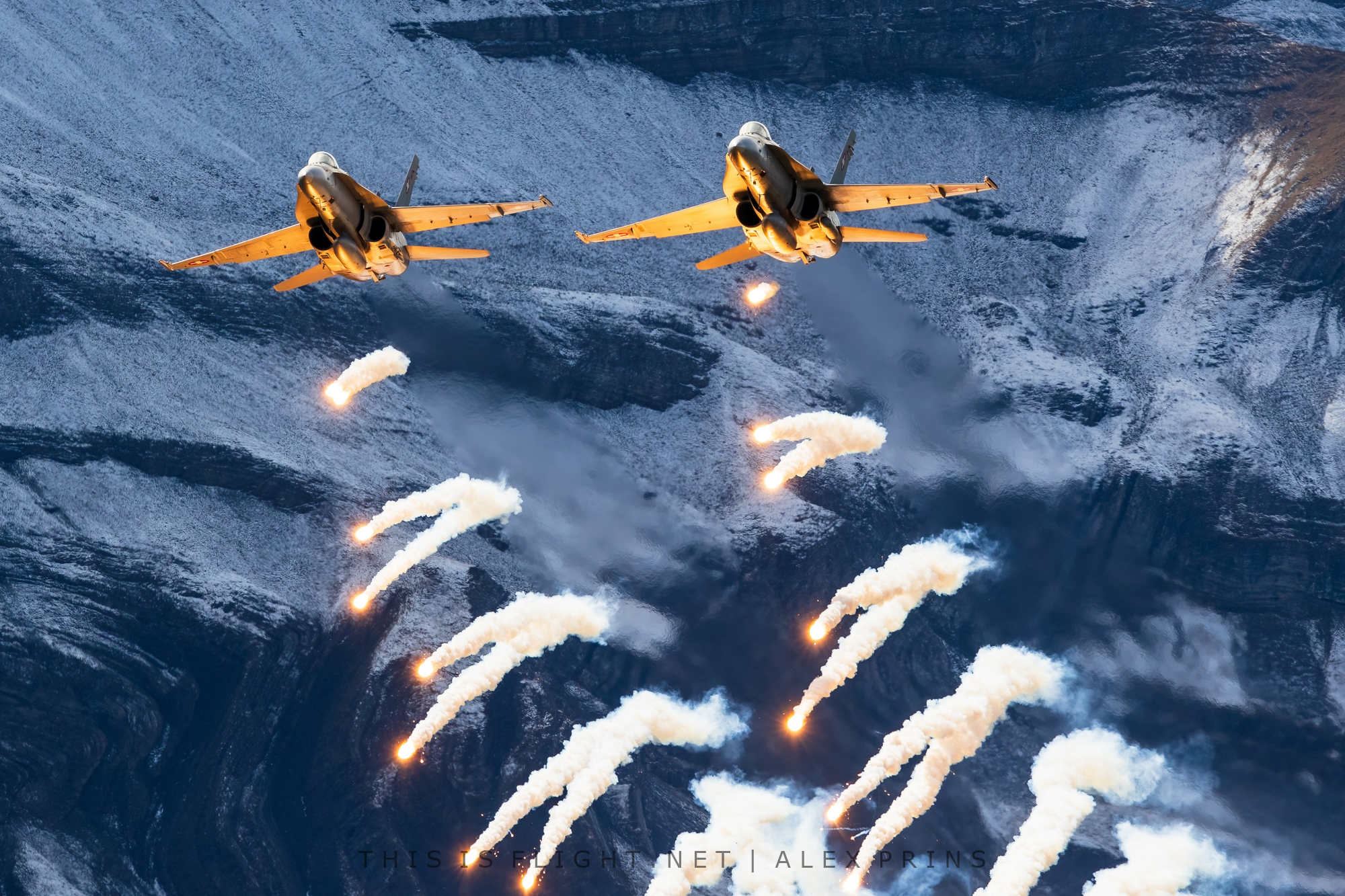
This feature will reflect my experience visiting for the first time in October 2023, a trip which takes on a greater significance with every announcement from the Swiss Armed Forces. I also offer advice for how to attend in future, in the optimistic hope that 2027 might see some semblance of a return to form, or perhaps the venue for one final hurrah for the Patrouille Suisse and F/A 18 Hornet displays.
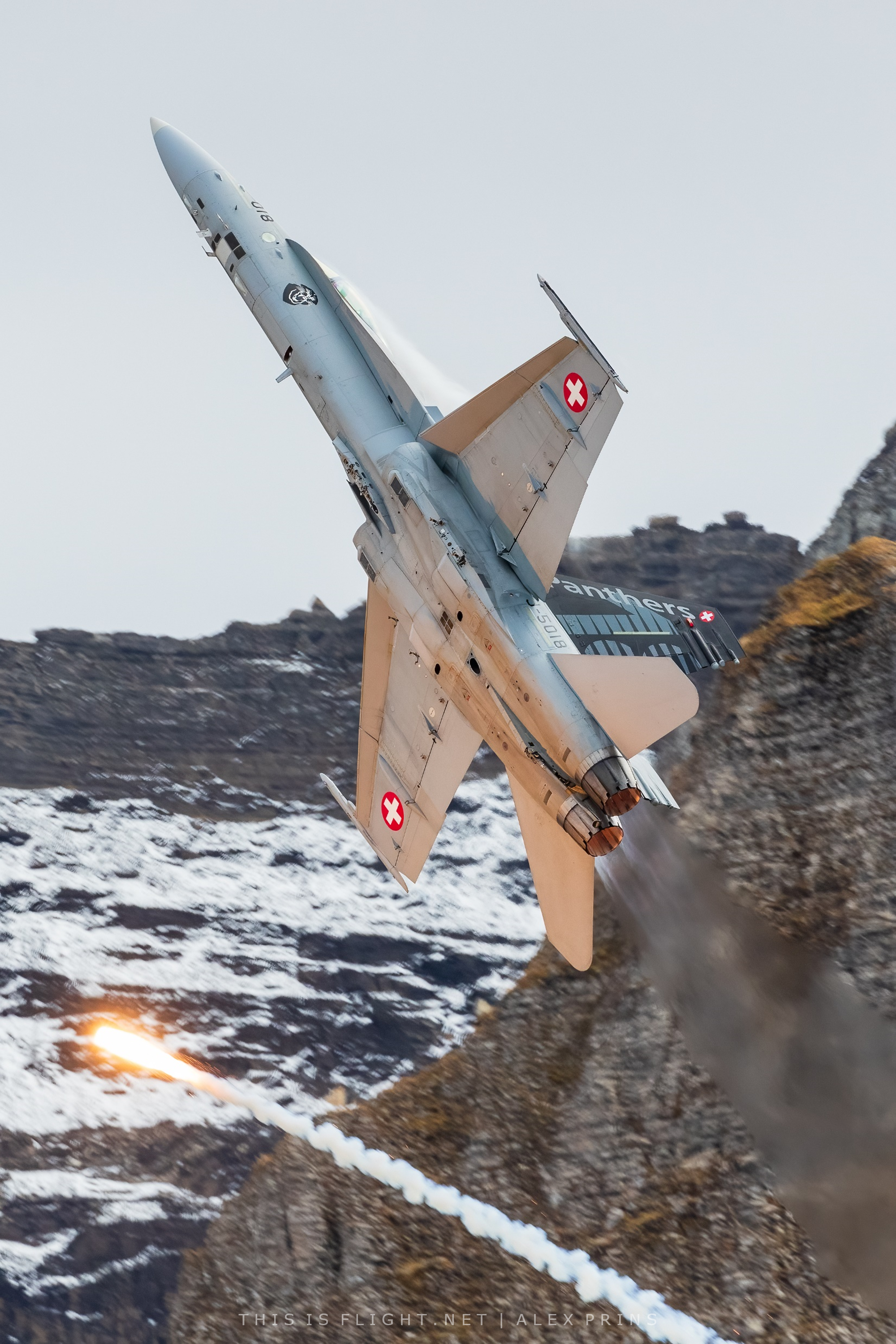
‘Axalp Fliegerschiessen’ literally refers to the “aviator shooting” exercises that take place in the Axalp valley of the Swiss Alps. As the trilingual commentary explains each day, the first military exercises took place in the valley in 1942, when Fieseler Storch aircraft landed on the slopes. In 1949 the first jets were introduced, as the de Havilland Vampire was first used in these defensive training manoeuvres. At one time, exercise bombs were deployed by aircraft such as Hawker Hunters, and the exercises were strictly off-limits to the public; this attitude thawed in the 1990s, and the public were welcomed to the slopes to watch. As such, an airshow element has grown, and the Hornet Display Team and Patrouille Suisse fly adapted routines to fit within the valley.
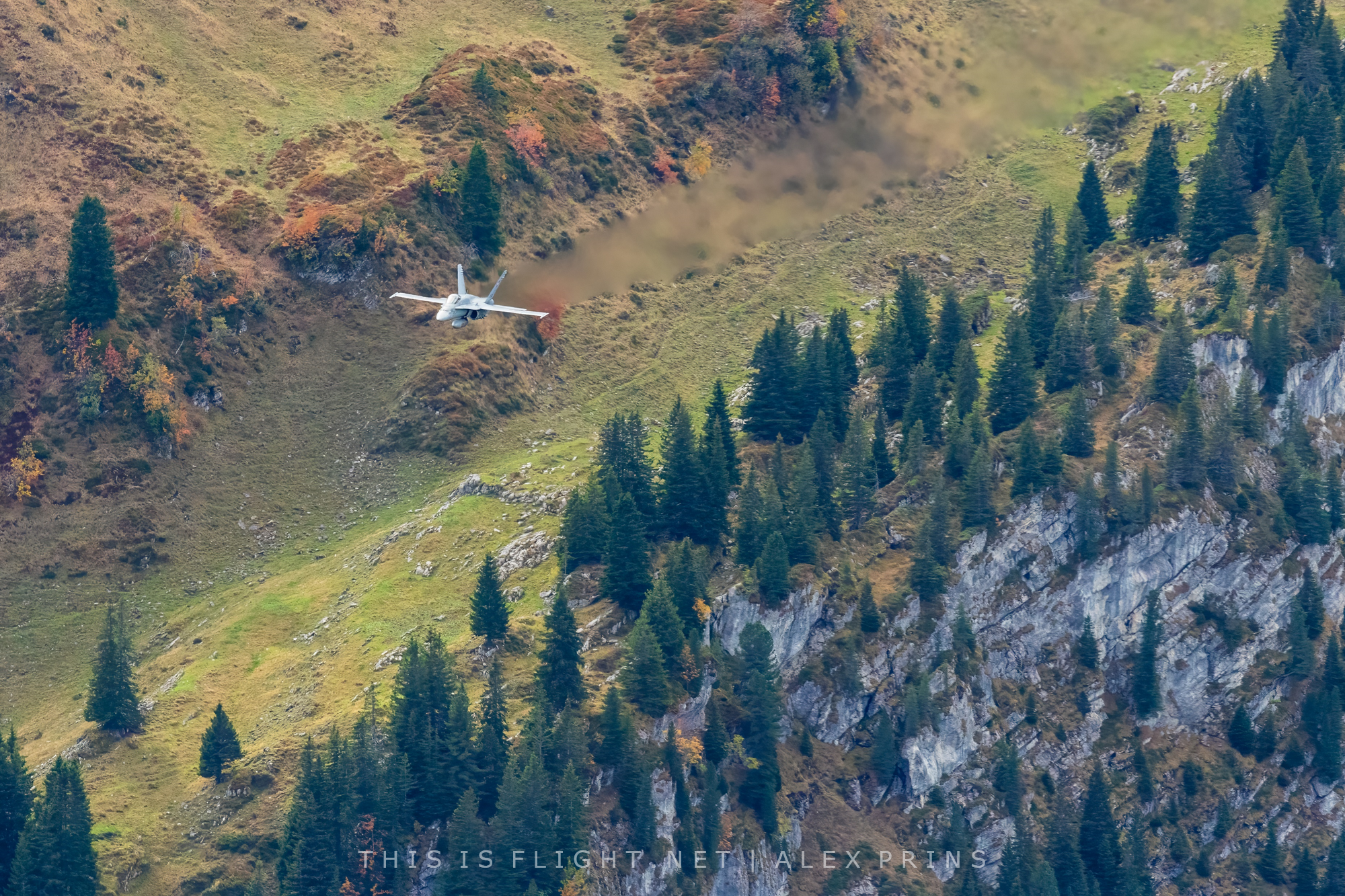
Held between 5,000-6,000ft above sea level, the event is obviously at the mercy of a multitude of factors. In previous years, as well as the Air14 precedence, the Air Force has cancelled the exercises in the wake of accidents and poor weather: in 2023 the final day’s flying was cancelled late on the evening prior, as the forecasted winds would have been prohibitive. In reality gusts never met the forecasts, however as the logistical efforts are significant, and highly susceptible to inclement conditions, all visitors accept the risk that for all their exertion no flying is guaranteed – although often there are refunds offered for any cancelled days.
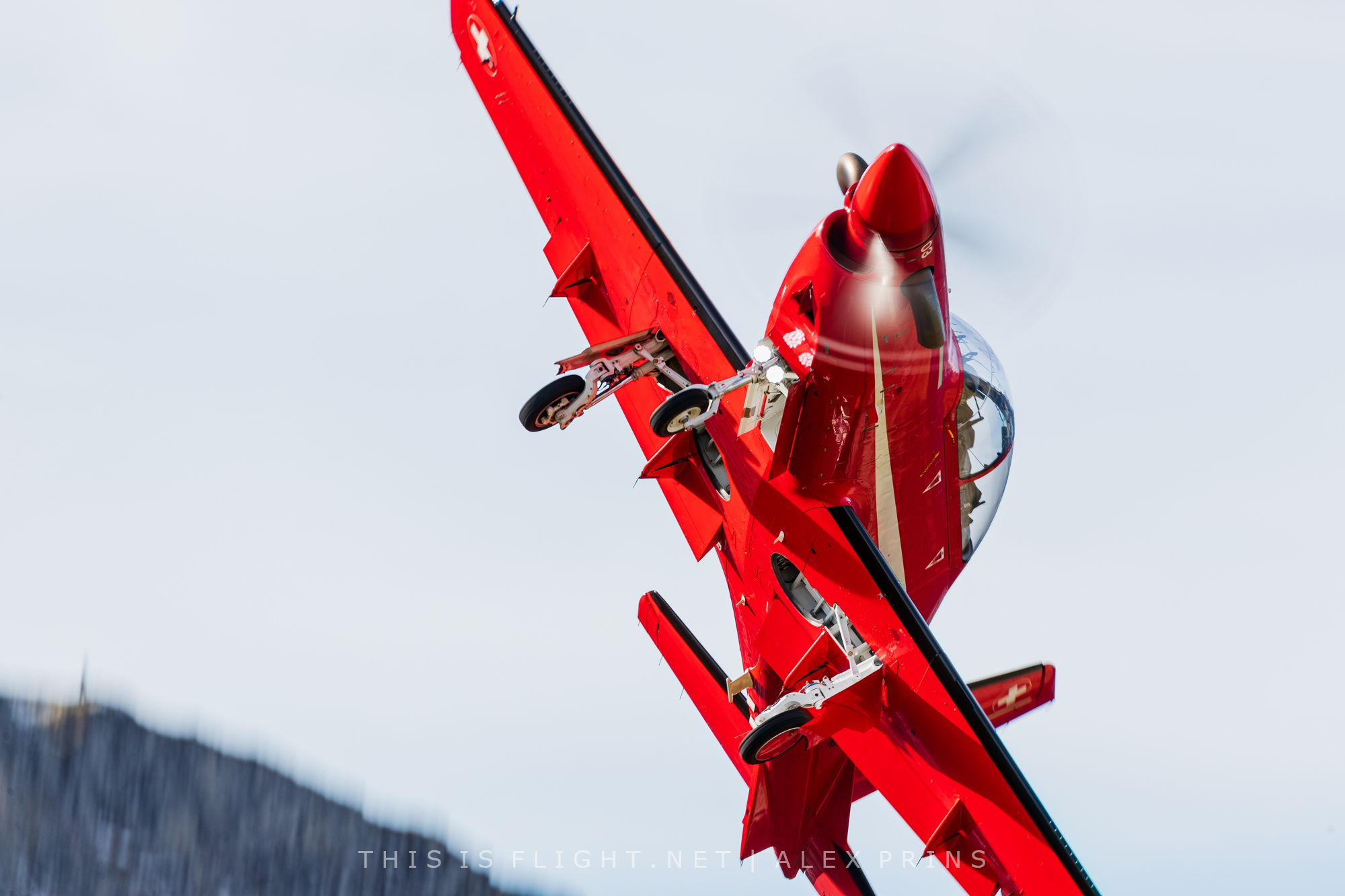
In advance of the event, you are advised to purchase tickets, which generally go on sale in early September; prices for the three days are CHF100 (around £90/$115), although various single-day packages are available. The official flying days are Tuesday (rehearsal), Wednesday and Thursday (airshow), although some hardy visitors often catch the earliest initial rehearsals the weekend prior.
Although the spectator areas are themselves unregulated in terms of access, the local council lays on shuttle buses from the Brienz valley, and there is a limited capacity. It is possible to ascend without this service, though this is only advisable for the very fittest visitors with experience of mountain hiking, and even then the 12km hike is likely to take in excess of four hours.
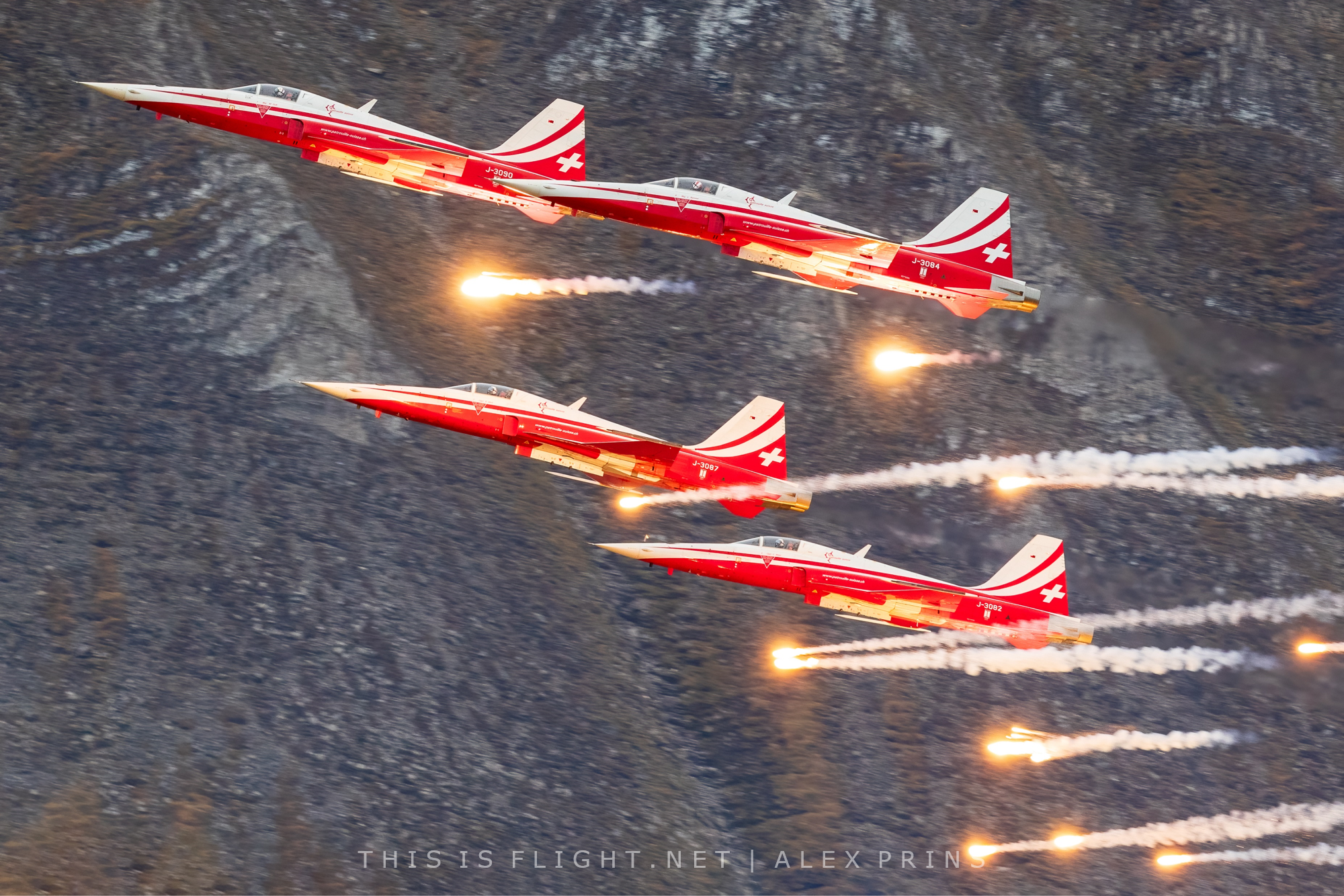
For an event in the middle of the Alps, public transport is remarkably accessible: shuttle bus services from Brienz train station ferry visitors to the Brienz ‘parkplatz’, where many visitors park (the roads around Axalp Tschingellift are closed to visiting traffic). The surrounding towns of Brienz, Meringen and Interlaken are often filled with the 10,000+ visiting public, so it is advisable to book accommodation well in advance. Once at the Brienz Park and Ride, a queue is formed for the ascending shuttle buses; considering that the single access road ascends the initial 4,000ft, a series of passing points and a well-coordinated radio network means the dizzying climb only takes around 30 minutes. The services run between 0500-1200 for the climb, and 1500-2200 for the return journey.
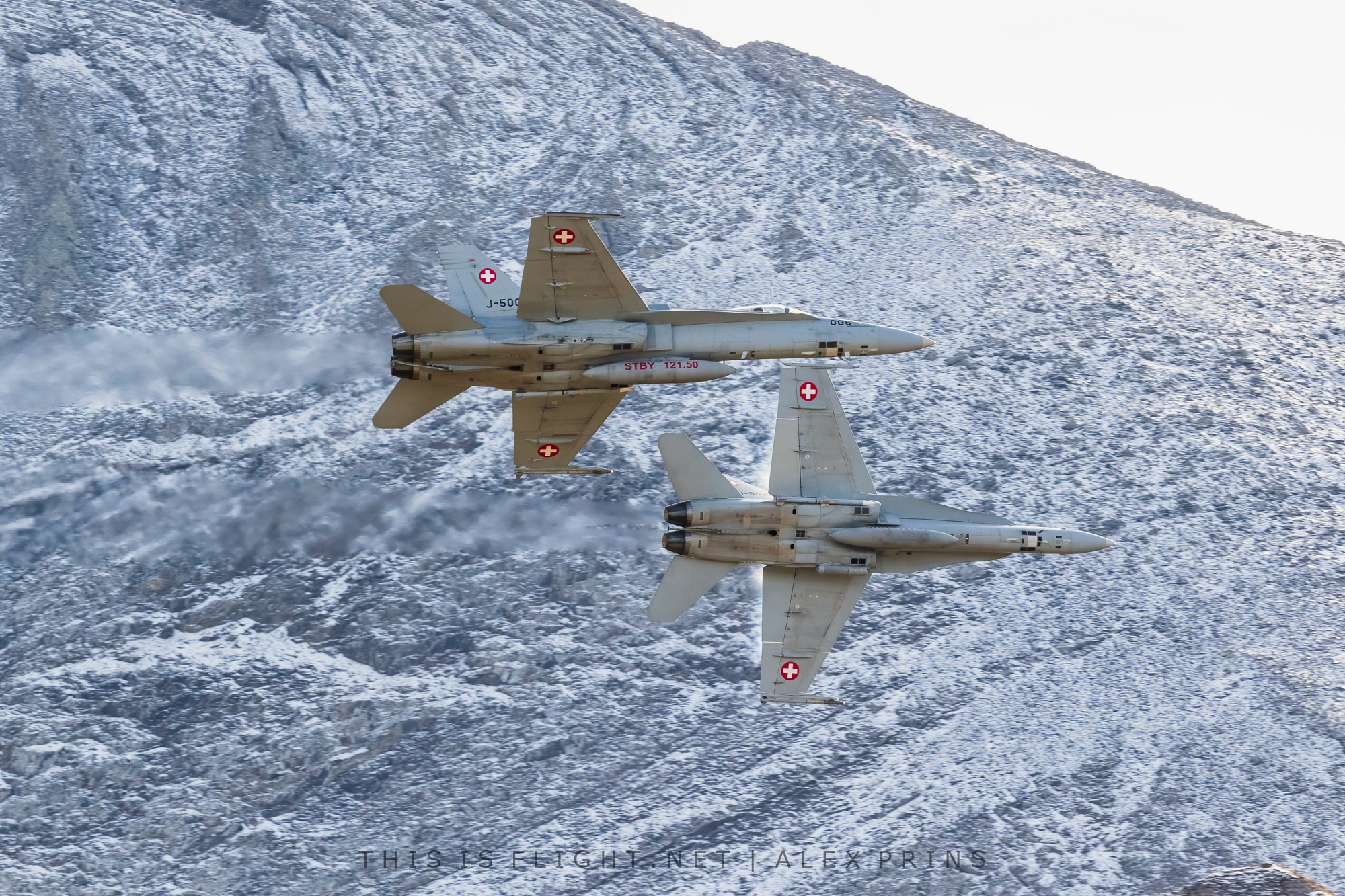
From the shuttle bus drop-off point, visitors have a choice for the next 2,000ft ascent between a chairlift or more circuitous hike. The chairlift queues may appear long, but do move quickly, and the benefit of this route is that the lift covers more than half of the remaining distance and deposits you only 1,000ft from Brau (the first possible viewpoint) – a walk that should take no more than two hours. Alternatively, you can comfortably walk from Axalp to Brau on footpaths and roads, and as a first-time visitor there are plenty of benches and vantage points to look over the Interlaken Valley. Both routes ultimately converge a few hundred feet from Brau at the steepest part of the initial ascent. It would be advisable when planning what equipment to bring to AXALP, to consider what you can carry for hours up steep grassy slopes; many experienced climbers still struggle, and hiking boots and accessories are almost definitely a necessity.
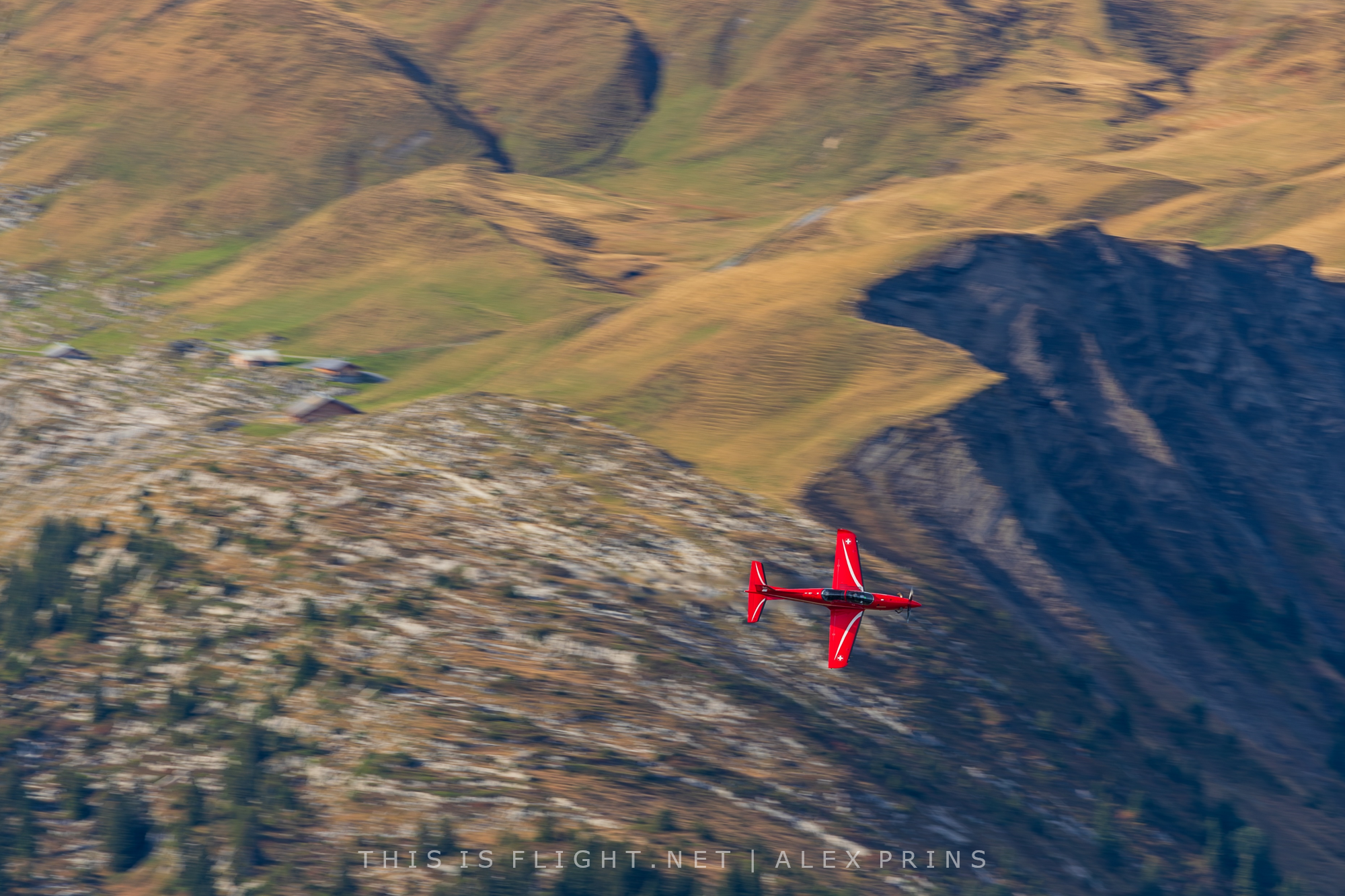
From Brau you have a view of the entry point into the Axalp-Ebenflüh shooting range, and sight of Target 1, the first aiming board that the Hornets will be shooting at. This position also offers views of the Brienz valley, where displays like the Patrouille Suisse generally reposition. The majority of the action happens over the brow of the next hill however, so this is a position best visited when you have experienced the main viewpoints, or cannot face a further climb.
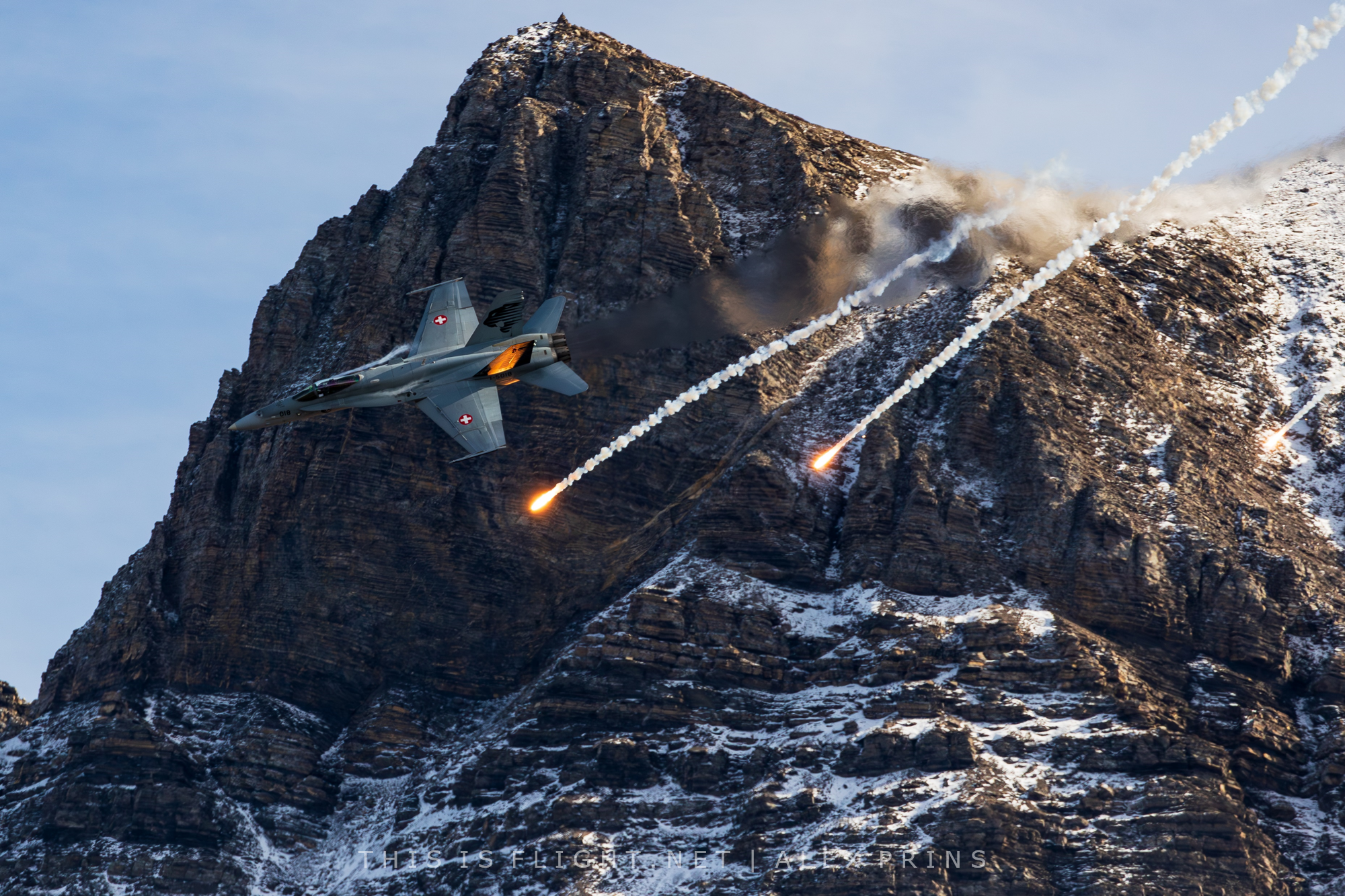
At this point it is wise to consider your aims for visiting AXALP: each position offers different benefits and drawbacks for photography, and there may be alternative spots to view from if you are simply there to enjoy the spectacle in-person. My best recommendation is to try multiple positions across the early training days or practice slots, and make your own decisions based on where you feel you might have “missed out”.
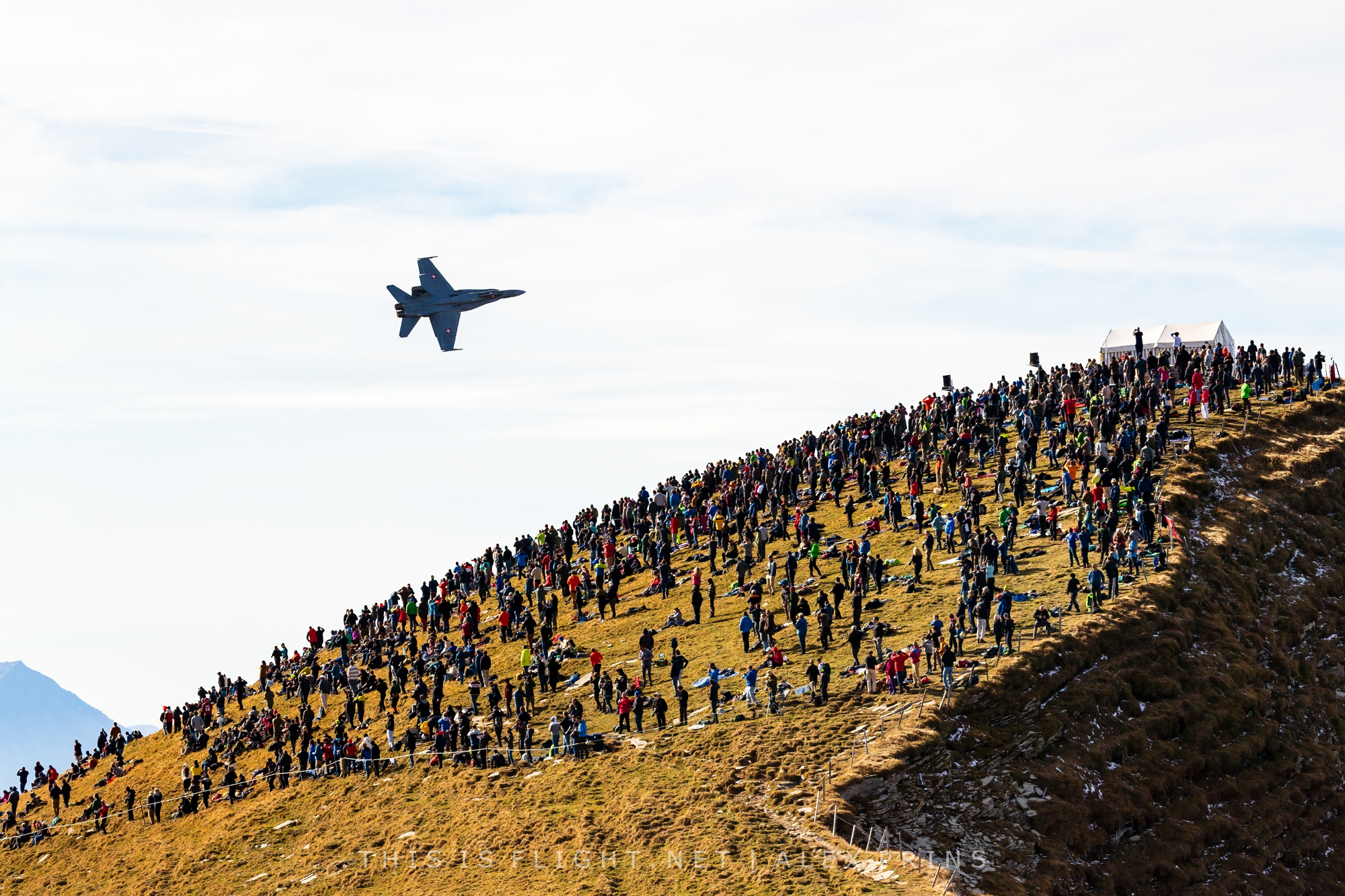
Onwards from Brau is the first of 2 main spectator hills: Tschingel (pictured above). Situated at 7,300ft, Tschingel is the largest spectator area, and offers views to/from the West (the right hand side as you sit on the face of the hill). Although some manoeuvres will still be out of sight, there is no single position at AXALP that offers everything; indeed, all of the official spectator areas face south and are backlit on sunny days. Adaptability is key: back light can offer the most spectacular vapour when aircraft are pulling G, and various other sightlines offer dramatic backdrops and conditions.
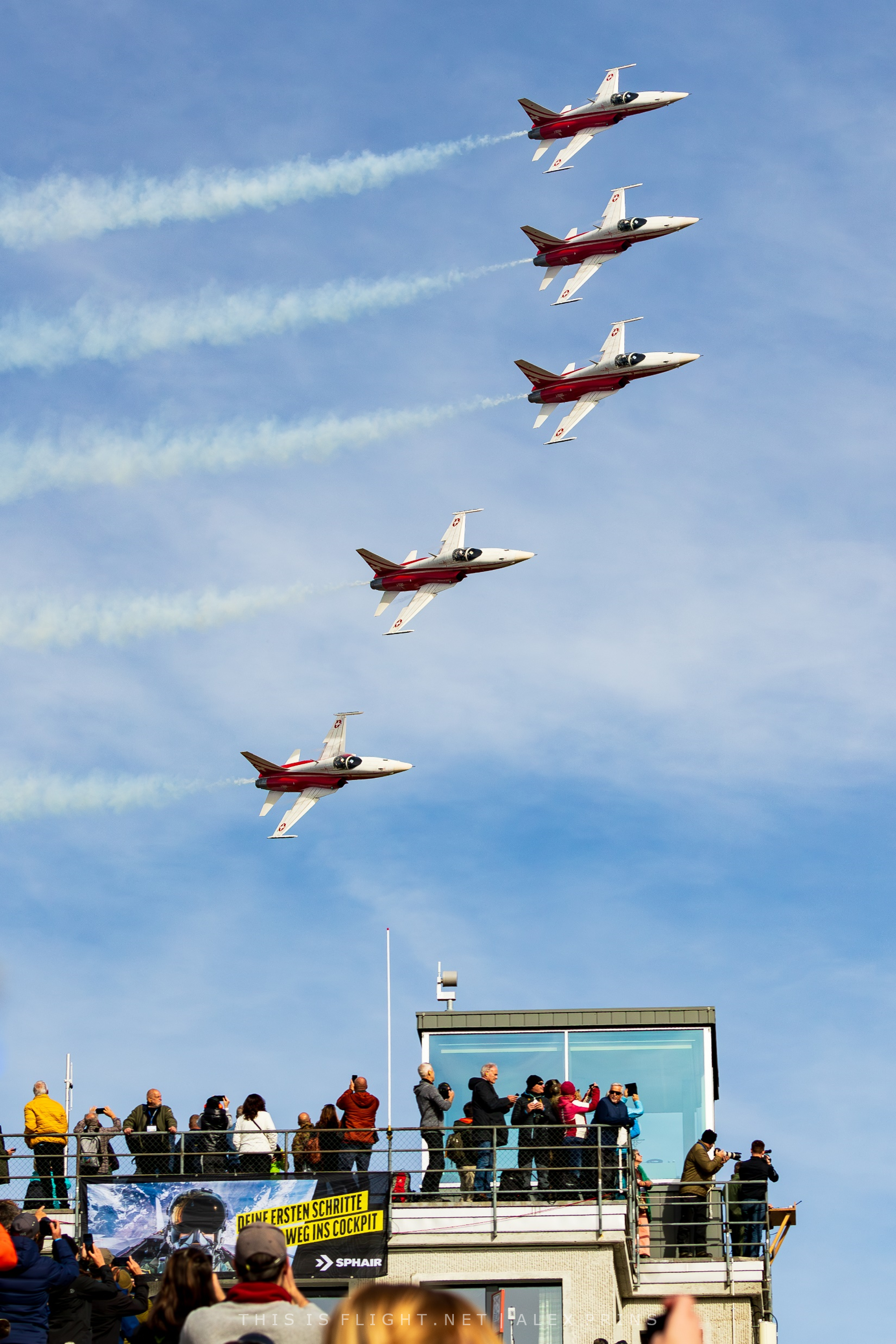
The final official spectator area is KP Ebenflüh (pictured above), so named for the Kommandoposten (Command Post) from which the shooting exercises are assessed and controlled. Although at a similar height above sea level as Tschingel, there is a further saddleback-shaped ridgeline to navigate between the two positions which adds extra time and exertion to your journey. The effort makes the final spectacle wholly more worthwhile however, and from the first flying activities you are rewarded. As with both Brau and Thschingel, KP offers different perspectives from different positions on the mountainside, due to the shape of the hill and the different approaches the various displays utilise. Once again, variety is the spice of life, and do consider moving around between days/activity slots.
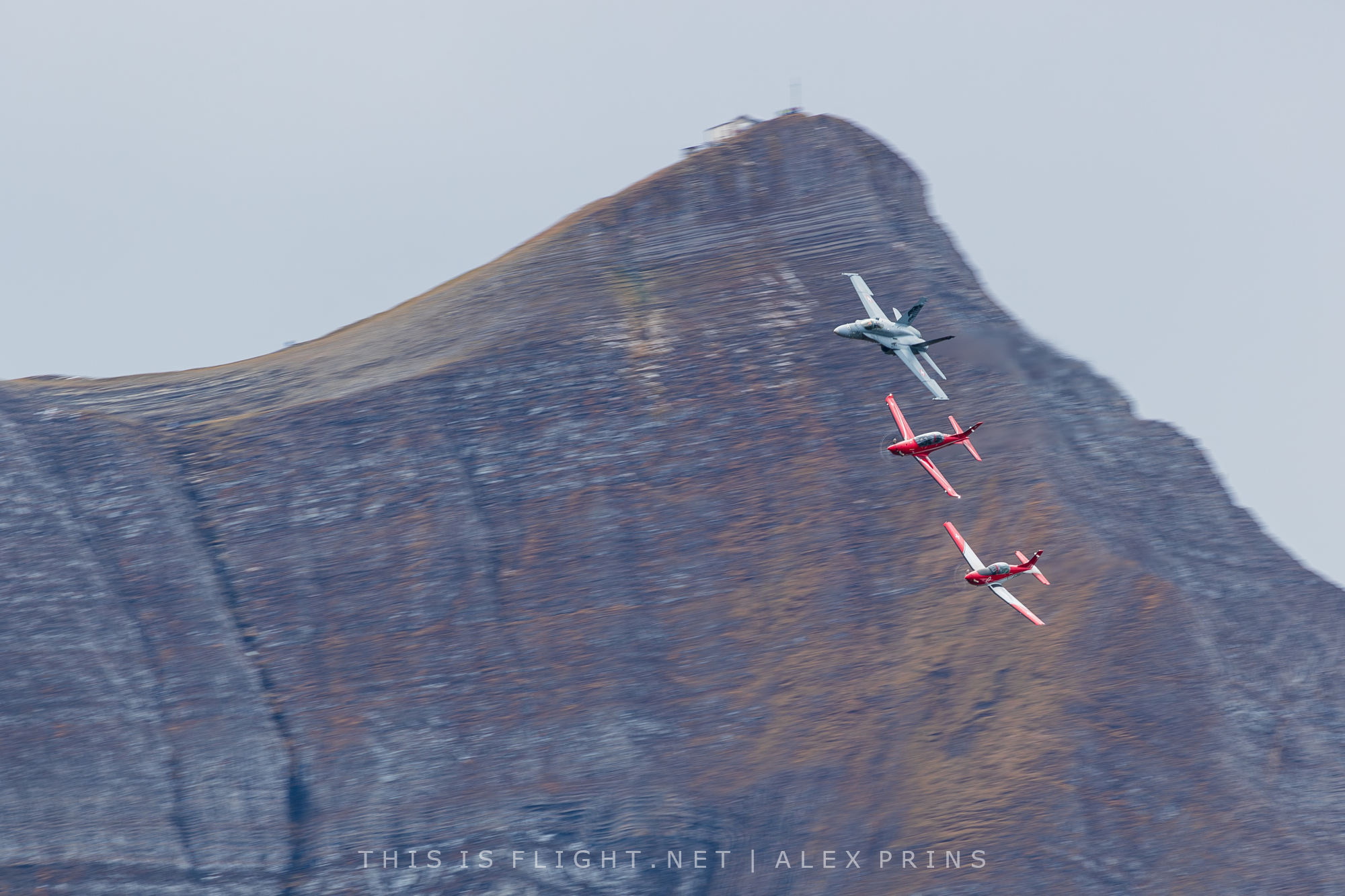
Note however, that access to Tschingel and KP is totally restricted before the start and end of the rehearsal and official flying slots for safety reasons, as aircraft operate overhead the transition spots with live ammunition and at extraordinary speeds. There are toilet facilities at all three official spectator hills, and drinks and hot food catering is available on the three official flying days courtesy of the Swiss Air Force, who supply the region by helicopter and maintain the whole huge operation. There is also Search and Rescue and medical helicopters on standby for the duration AXALP, and unfortunately it has been known for unwitting visitors to be fatally injured. Such is the nature of ten thousand “tourists” converging on one mountain range, and it cannot be stressed enough that your own safety should be priority. There may be times where you feel a need to rush the ascent/descent, but there is nothing more important than enjoying the event without injury or incident.
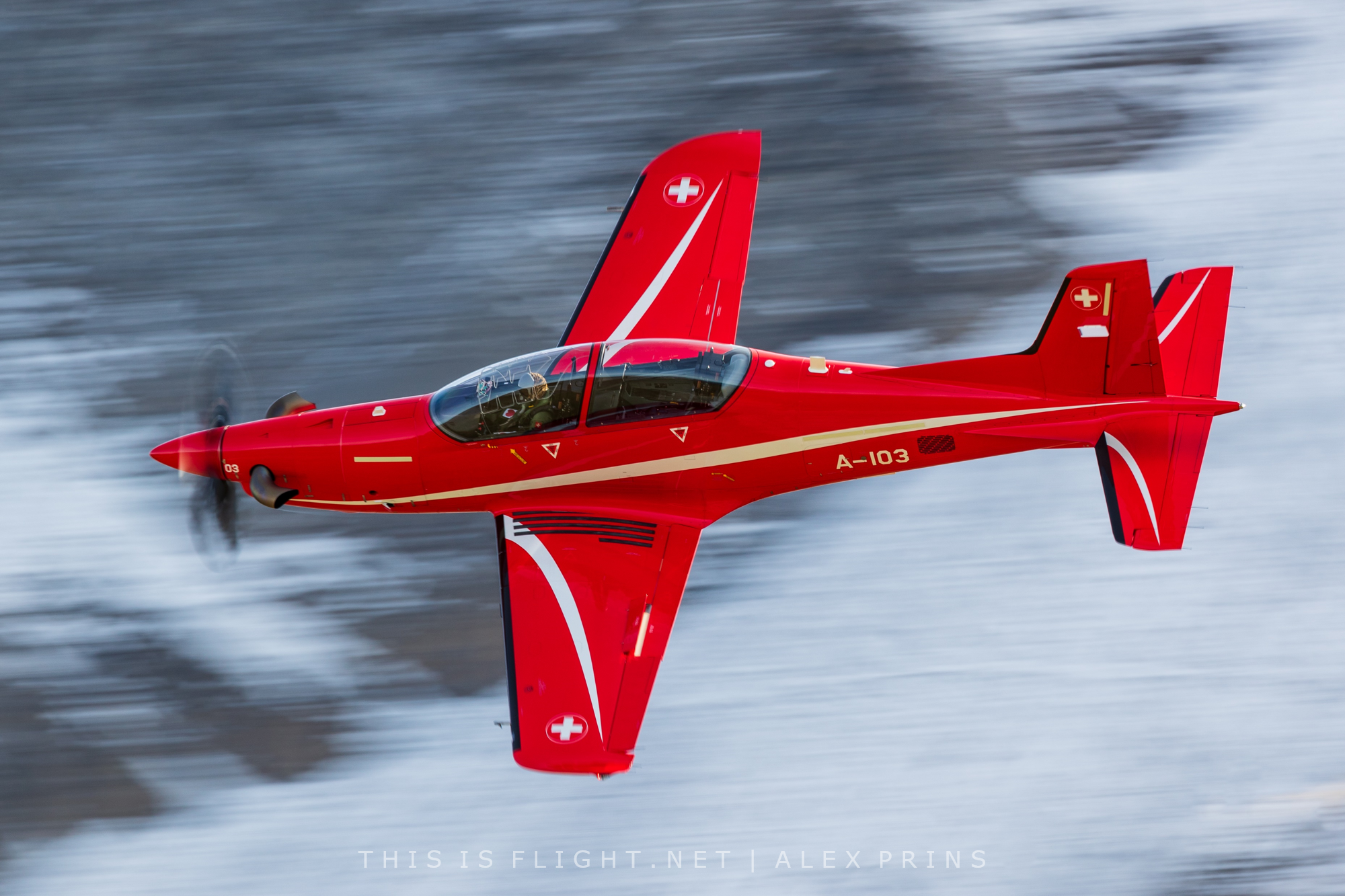
The flying programme itself runs from 1400 until around 1530, and the uninitiated may question the expense and effort required for only 90 minutes of flying! In reality, many begin the ascent before sunrise, to be in position on the mountainside for the first flights from Meiringen Air Base. These early recon trips arrive overhead at around 0900, while extra live-firing rehearsals take place between 1100-1300. It is also common for the solo PC-21 to fly extended displays, and in 2023 these occurred in some of the best light, and lasted for in excess of twenty minutes.
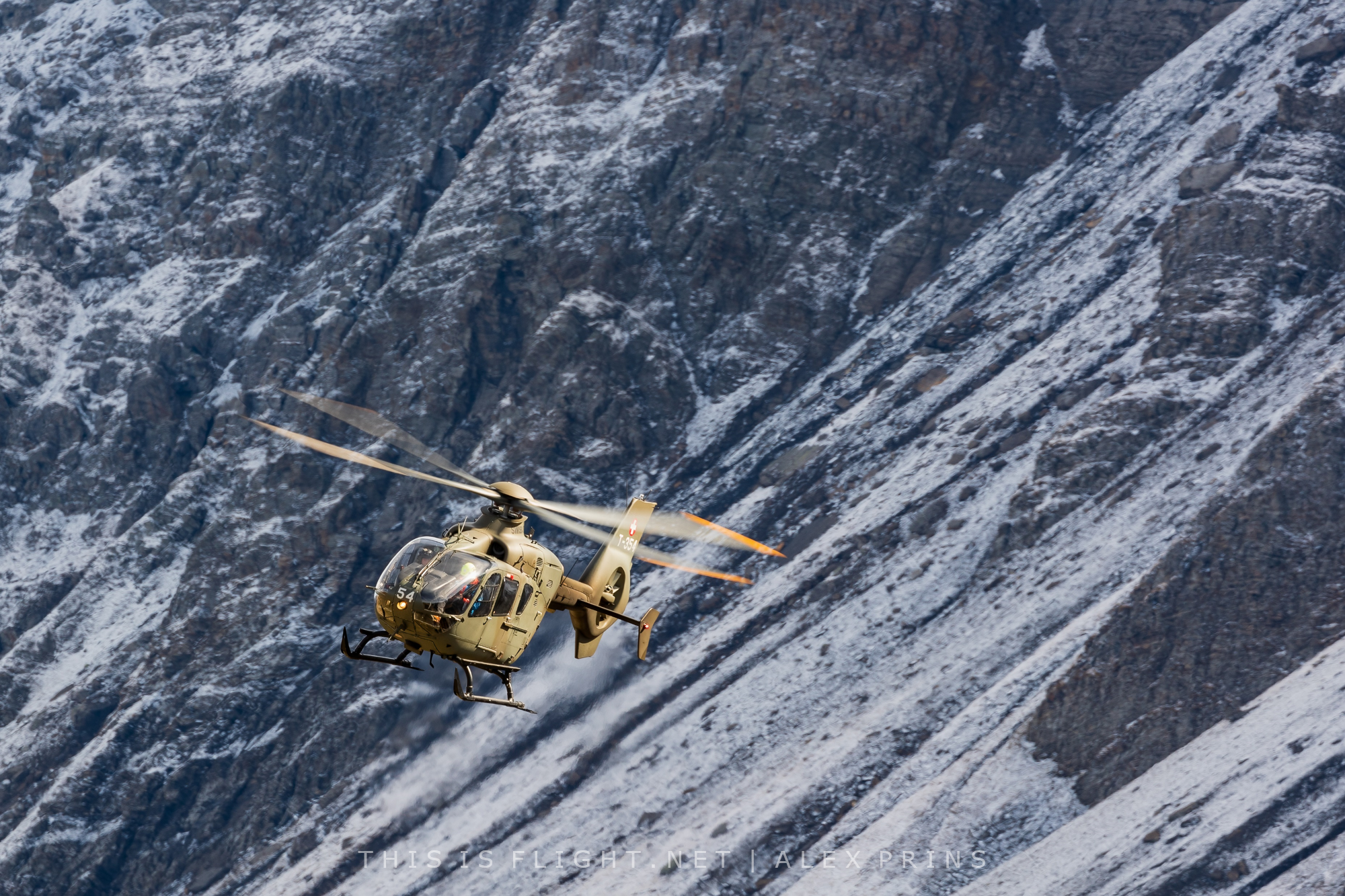
There are also almost-continuous VIP shuttle flights of Super Pumas transiting between the KP and Meiringen, and a protracted Eurocopter EC-135 survey of the hillsides: apparently using equipment such as thermal-imaging cameras to root out any potential trespassers on the shooting range. In all, if the weather is kind (which of course is no guarantee in October in the Alps) then to spend a day in the Alpine heights with beer and raclette freely available is quite some way to pass the time!
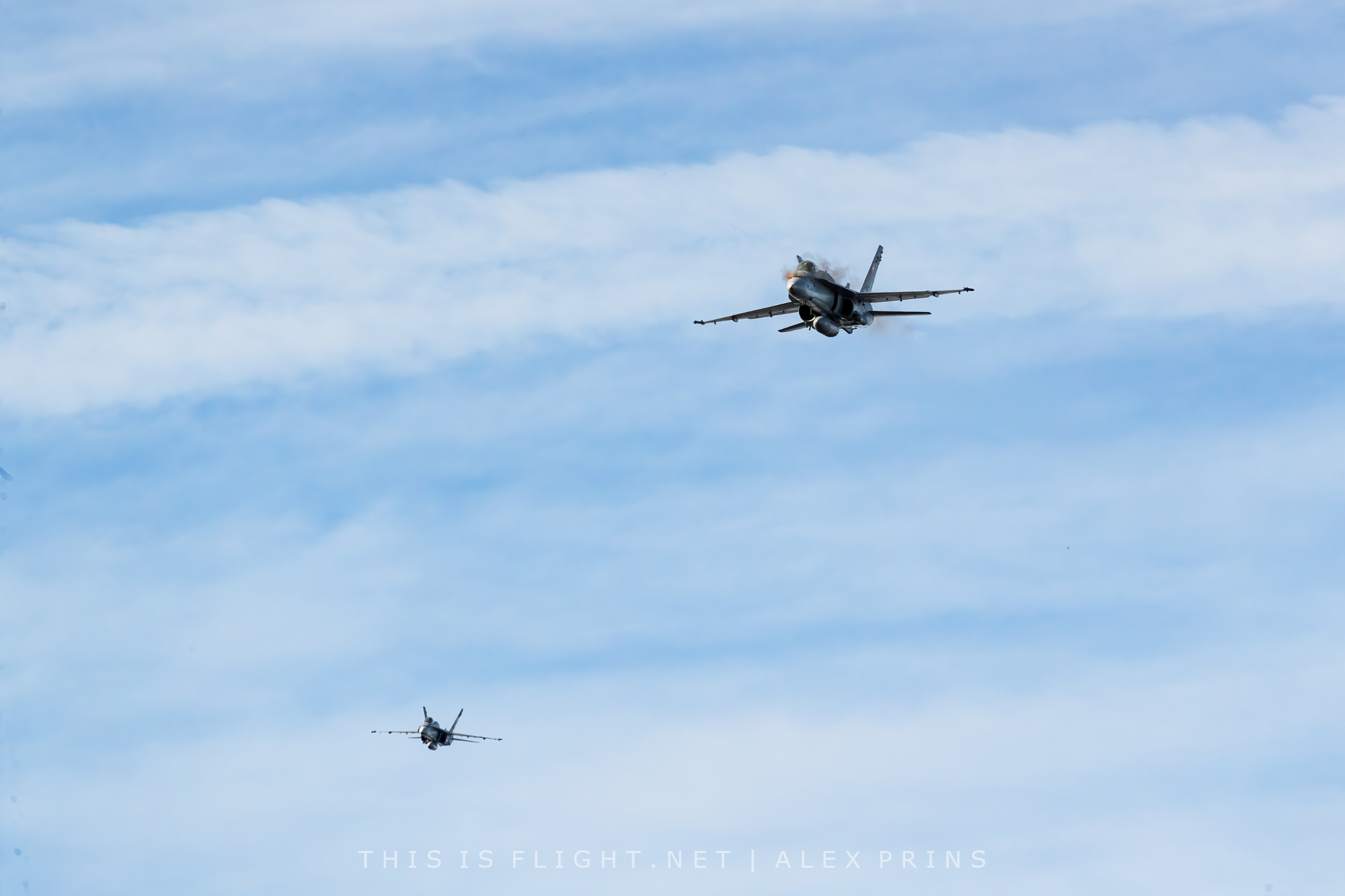
The official portion of the Axalp Fliegerschiessen is broadly predictable year-on-year, though surprise acts like the Italian F-35s in 2022 and Swedish Gripens in 2013 add to the varied spectacle. At 1400 a formation of F/A-18 Hornets signals the opening of the flying display, with some formation manoeuvres (generally 3-4 aircraft) and invariably a sneak pass. The Hornets then spend 20 minutes firing in various combinations at Targets 1-3, in passes from the West and the North. Photos and videos genuinely don’t convey the raw energy of four twin-burner fast jets firing overhead at targets, then peeling out of sight around a mountainside or rolling inverted and disappearing behind Wildgärst, where you can often spot the odd adventurous photographer in an unofficial (yet permissible) viewpoint. Every manoeuvre at AXALP is a genuine operational exercise, and the target shooting is not for show: it demonstrates the Swiss Air Force’s ability to defend itself in any arena, and thus the accuracy of the cannonfire from each aircraft is assessed and scored.
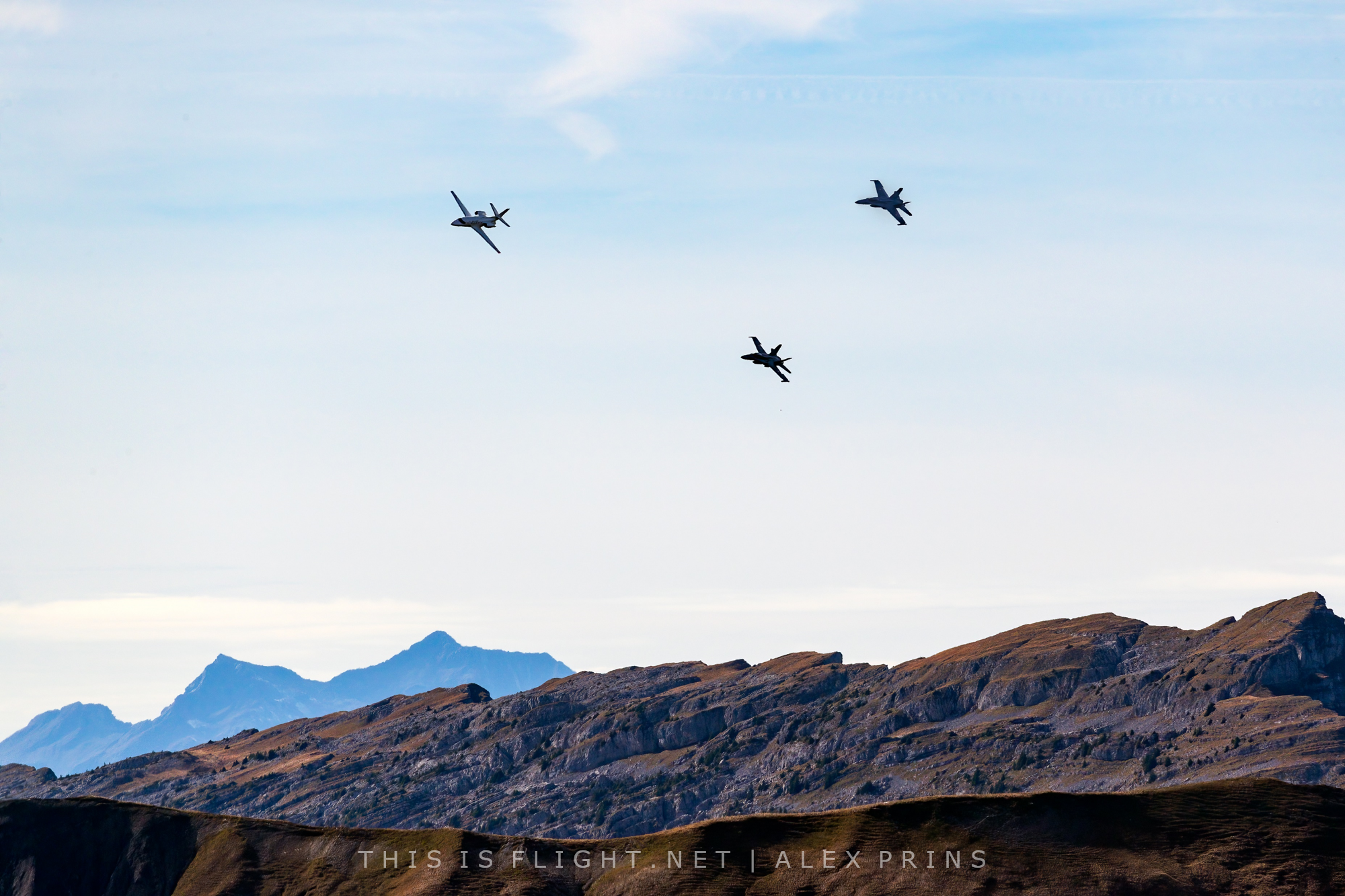
Alongside the air-to-ground shooting, the Swiss Air Force also conducts a variety of other demonstrations of their defensive capabilities, including a mock interception of an uncommunicative Cessna Citation 560 XL. In a series of passes over the valley, two F/A-18s approach the aircraft, fire a short salvo of flares to gain the crew’s attention, then guide the Citation to a safe landing at Meiringen. Similarly, a slow-moving PC-7 is “intercepted” by a Super Puma, whose crew signal their intentions with a hand-fired flare, and ensure compliance with numerous firearms. Further demonstrations with a visual element include a patriotic parachute drop from two PC-6 Porter aircraft, the latter of which then demonstrate that even the more unwieldy jumpships can hug the Alpine contours!
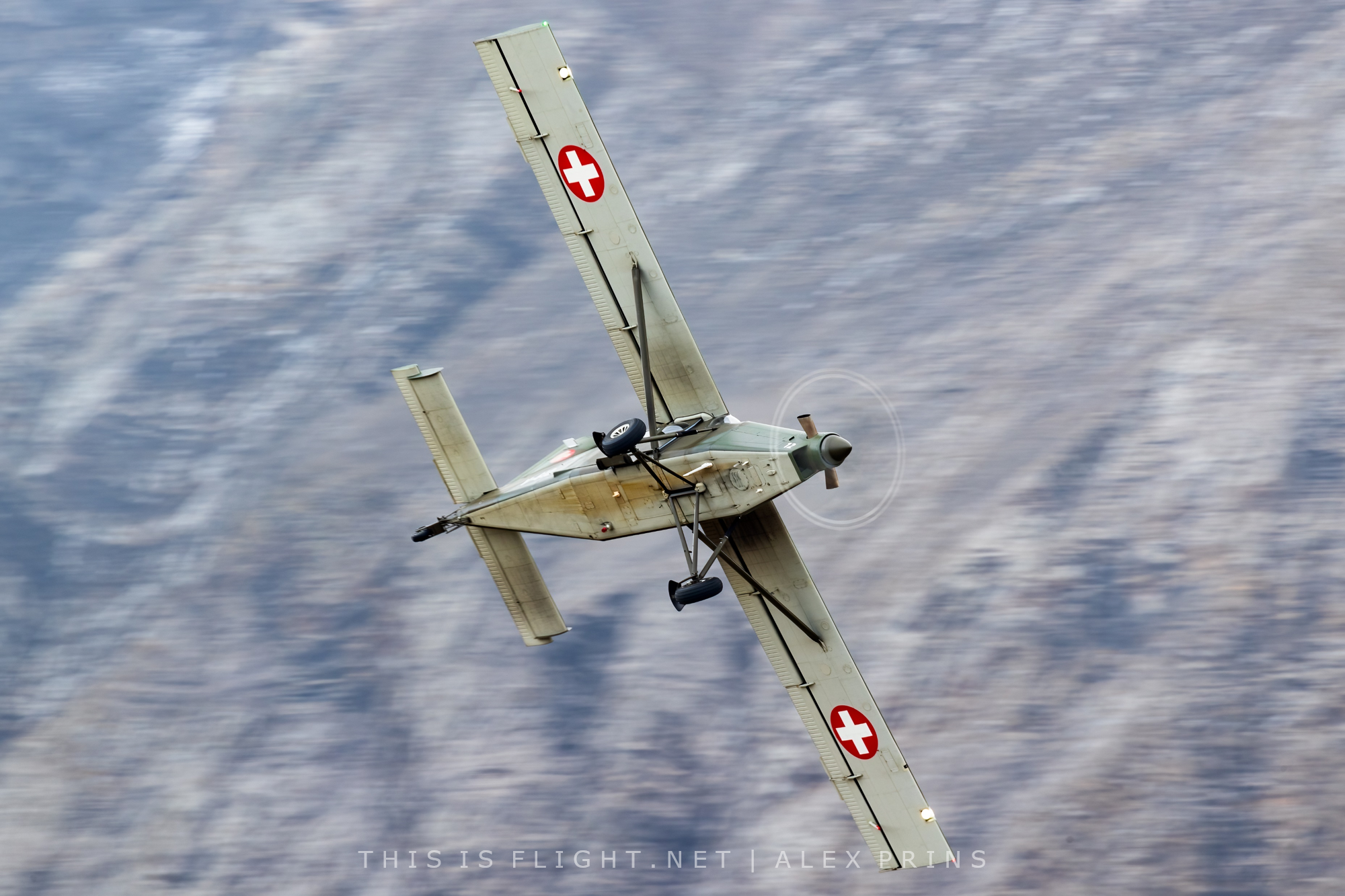
There is no published flying schedule, and one can never be sure what to expect (beyond what is published by the formal display teams). In previous years, the Hornets’ live firing has been followed by Super Puma helicopters carrying ‘Bambi’ buckets in a demonstration of their firefighting role. In 2023 this was unfortunately missing, as was the exceptional Super Puma solo display, due to crew illness and unavailability. Instead, a commando assault was carried out by 8 soldiers of the Special Forces Command (KSK), who were inserted via helicopter, and extracted a short while later on a daisy-chain harness, having captured the hillside and mounted an assault on their targets with a variety of firearms and rocket-propelled grenades. Lastly, symbolic flypasts are generally common and varied, including combinations of the F/A-18 and Pilatus trainers.
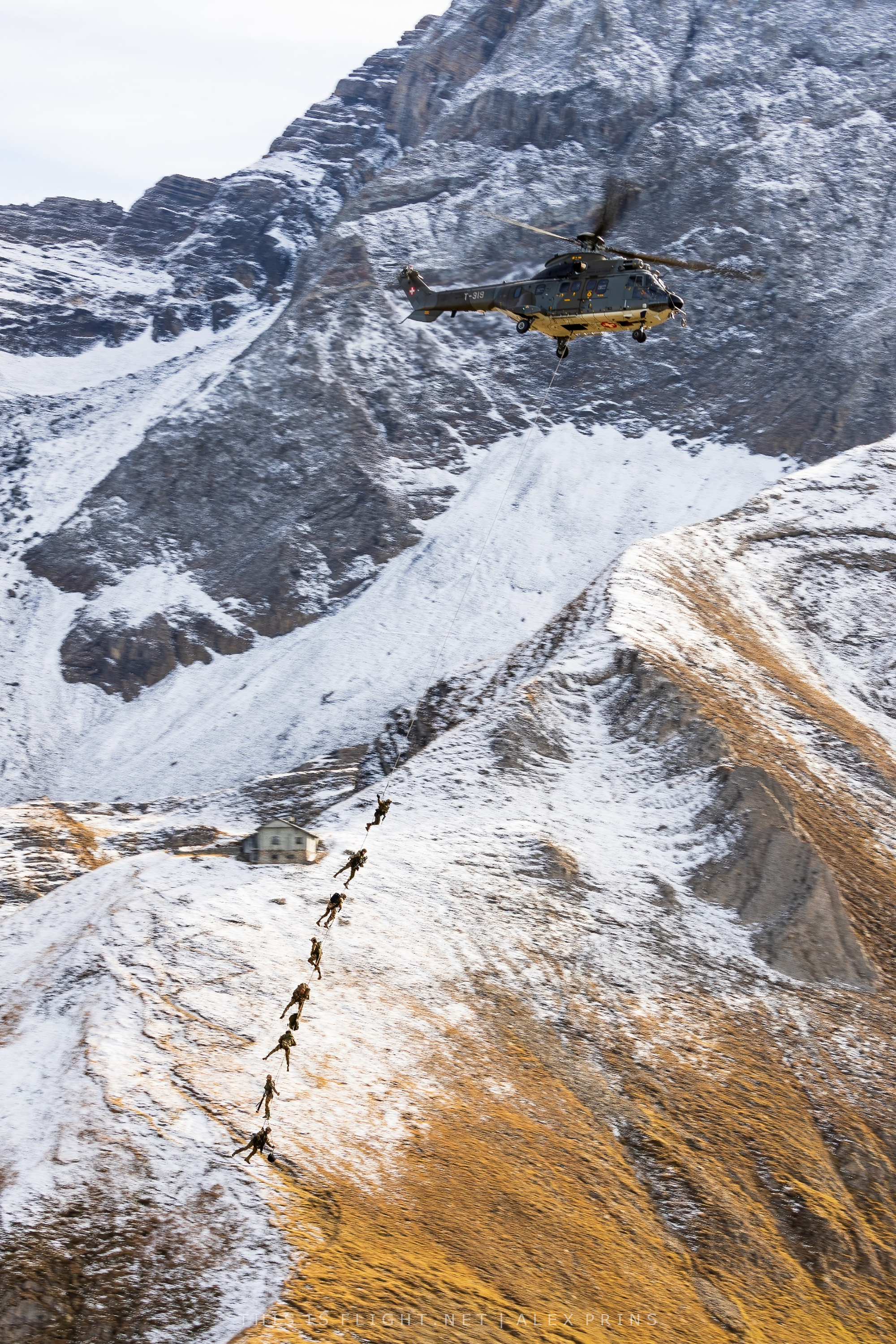
The flying “display” is then traditionally concluded by the Patrouille Suisse, whose adapted display in this alpine setting is probably the most exceptional combination of aircraft, airmanship and scenery, anywhere in the world. As the team flies its final break, dispensing their remaining flares over the valley, most visitors begin their descent. Oftentimes there may be further formations of Super Pumas, however most spectators will have begun the return trip; at this point it is even more vital to remain vigilant of your surroundings, as even the most experienced hikers may find themselves in trouble when descending while laden with extra bags, or in a rush to beat the queues. Take the return journey at your own pace: there are service people positioned by the military to provide assistance where required, and the queues for the return shuttle busses are fast-moving and efficiently managed.
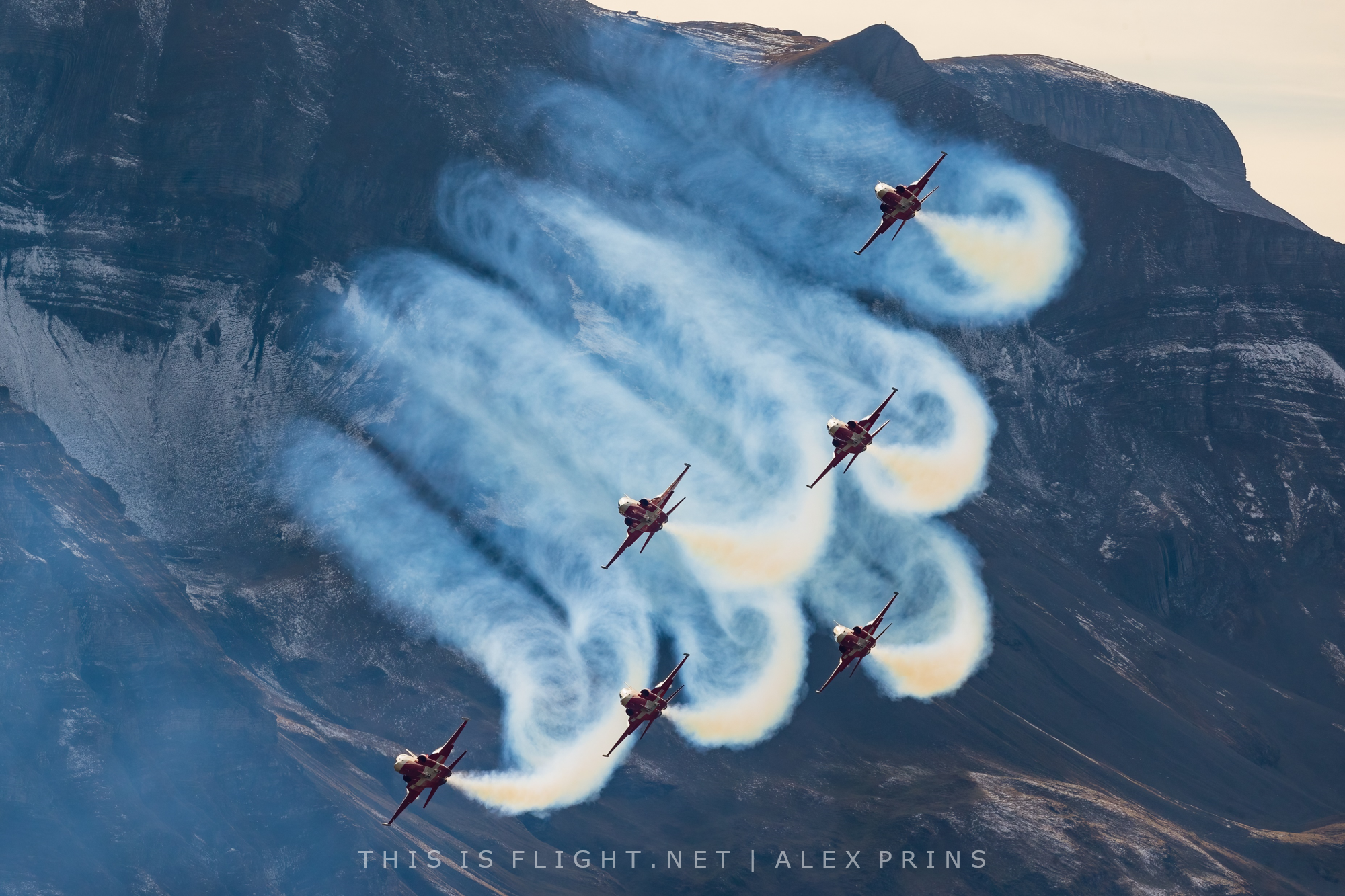
You will arrive at the bottom of the valley tired and aching, but with an almost universal sense of euphoria. Those that have experienced AXALP are permanently changed: no other aerial event challenges you in this way, nor can anything else trigger the overwhelming rush of adrenaline when that first Hornet tears overhead towards a target. I truly hope that in 2027, after this unwelcome furlough, the hills will once again be alive with the sound of afterburners.
